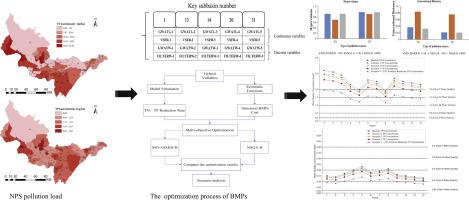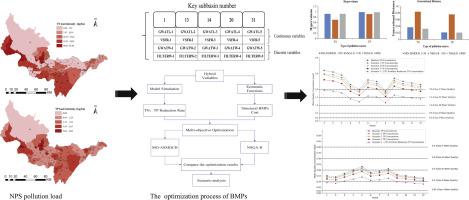Surrogate modelling-based multi-objective optimization for best management practices of nonpoint source pollution
IF 11.4
1区 环境科学与生态学
Q1 ENGINEERING, ENVIRONMENTAL
引用次数: 0
Abstract
The integrated application of hydrological models and best management practices (BMPs) serves as a pivotal decision-making tool for managing nonpoint source (NPS) pollution in watersheds. Optimizing and selecting BMP options are critical challenges in managing NPS pollution, as these processes are typically computationally expensive and involve mixed discrete-continuous decision variables. Our study integrated a novel method, the multi-objective adaptive surrogate modeling-based optimization for constrained hybrid problems (MO-ASMOCH), with the distributed Soil and Water Assessment Tool (SWAT) model to efficiently optimize the deployment of BMPs in the Four Lakes watershed of China. We compared the optimization results with those obtained using the traditional non-dominated sorting genetic algorithm (NSGA-II) method. Our results demonstrate that MO-ASMOCH significantly outperforms NSGA-II in computational efficiency, achieving comparable Pareto-optimal solutions with just 1,150 model evaluations compared to NSGA-II's requirement of 10,000 model evaluations. This demonstrates that MO-ASMOCH is a more efficient optimization algorithm for BMP optimization problems with both discrete and continuous decision variables. We selected representative scenarios to calculate in-lake concentrations of total phosphorus (TP) and total nitrogen (TN) pollutant loads. The largest reduction scenario could reduce TN and TP loads by 18.3 % and 20.7 %, respectively, at a cost of 1.54 × 108 Chinese Yuan. Under this scenario, the water quality classification level of TN improves from inferior Class V to Class IV-V, while TP attains Class III throughout the year. The methods of this study could enhance our capability to manage NPS pollution in watersheds effectively and provide targeted decision-making insights for environmental management practices.


基于代用模型的多目标优化非点源污染最佳管理实践
综合应用水文模型和最佳管理实践(BMP)是管理流域非点源(NPS)污染的关键决策工具。优化和选择 BMP 方案是管理 NPS 污染的关键挑战,因为这些过程通常计算成本高昂,而且涉及离散-连续混合决策变量。我们的研究将一种新方法--基于多目标自适应代理建模的约束混合问题优化(MO-ASMOCH)--与分布式水土评估工具(SWAT)模型相结合,有效地优化了中国四湖流域的 BMP 部署。我们将优化结果与传统的非支配排序遗传算法(NSGA-II)进行了比较。结果表明,MO-ASMOCH 的计算效率明显优于 NSGA-II,与 NSGA-II 所需的 10,000 次模型评估相比,MO-ASMOCH 只需 1,150 次模型评估就能获得相当的帕累托最优解。这表明,对于具有离散和连续决策变量的 BMP 优化问题,MO-ASMOCH 是一种更高效的优化算法。我们选择了具有代表性的方案来计算总磷 (TP) 和总氮 (TN) 污染负荷的湖内浓度。最大削减方案可使 TN 和 TP 负荷分别减少 18.3% 和 20.7%,成本为 1.54 × 108 元人民币。在此方案下,TN 的水质级别由劣 V 类提高到 IV-V 类,TP 全年达到 III 类。本研究的方法可提高我们有效治理流域内非污染源污染的能力,并为环境管理实践提供有针对性的决策启示。
本文章由计算机程序翻译,如有差异,请以英文原文为准。
求助全文
约1分钟内获得全文
求助全文
来源期刊

Water Research
环境科学-工程:环境
CiteScore
20.80
自引率
9.40%
发文量
1307
审稿时长
38 days
期刊介绍:
Water Research, along with its open access companion journal Water Research X, serves as a platform for publishing original research papers covering various aspects of the science and technology related to the anthropogenic water cycle, water quality, and its management worldwide. The audience targeted by the journal comprises biologists, chemical engineers, chemists, civil engineers, environmental engineers, limnologists, and microbiologists. The scope of the journal include:
•Treatment processes for water and wastewaters (municipal, agricultural, industrial, and on-site treatment), including resource recovery and residuals management;
•Urban hydrology including sewer systems, stormwater management, and green infrastructure;
•Drinking water treatment and distribution;
•Potable and non-potable water reuse;
•Sanitation, public health, and risk assessment;
•Anaerobic digestion, solid and hazardous waste management, including source characterization and the effects and control of leachates and gaseous emissions;
•Contaminants (chemical, microbial, anthropogenic particles such as nanoparticles or microplastics) and related water quality sensing, monitoring, fate, and assessment;
•Anthropogenic impacts on inland, tidal, coastal and urban waters, focusing on surface and ground waters, and point and non-point sources of pollution;
•Environmental restoration, linked to surface water, groundwater and groundwater remediation;
•Analysis of the interfaces between sediments and water, and between water and atmosphere, focusing specifically on anthropogenic impacts;
•Mathematical modelling, systems analysis, machine learning, and beneficial use of big data related to the anthropogenic water cycle;
•Socio-economic, policy, and regulations studies.
 求助内容:
求助内容: 应助结果提醒方式:
应助结果提醒方式:


